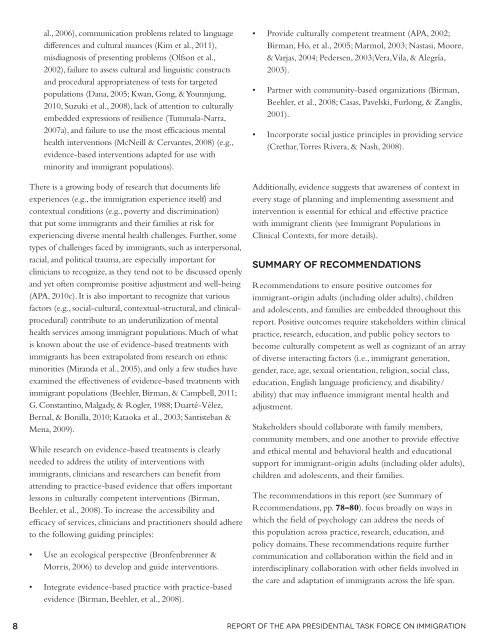Crossroads: The Psychology of Immigration in the New Century
Crossroads: The Psychology of Immigration in the New Century
Crossroads: The Psychology of Immigration in the New Century
Create successful ePaper yourself
Turn your PDF publications into a flip-book with our unique Google optimized e-Paper software.
al., 2006), communication problems related to language<br />
differences and cultural nuances (Kim et al., 2011),<br />
misdiagnosis <strong>of</strong> present<strong>in</strong>g problems (Olfson et al.,<br />
2002), failure to assess cultural and l<strong>in</strong>guistic constructs<br />
and procedural appropriateness <strong>of</strong> tests for targeted<br />
populations (Dana, 2005; Kwan, Gong, & Younnjung,<br />
2010, Suzuki et al., 2008), lack <strong>of</strong> attention to culturally<br />
embedded expressions <strong>of</strong> resilience (Tummala-Narra,<br />
2007a), and failure to use <strong>the</strong> most efficacious mental<br />
health <strong>in</strong>terventions (McNeill & Cervantes, 2008) (e.g.,<br />
evidence-based <strong>in</strong>terventions adapted for use with<br />
m<strong>in</strong>ority and immigrant populations).<br />
<strong>The</strong>re is a grow<strong>in</strong>g body <strong>of</strong> research that documents life<br />
experiences (e.g., <strong>the</strong> immigration experience itself) and<br />
contextual conditions (e.g., poverty and discrim<strong>in</strong>ation)<br />
that put some immigrants and <strong>the</strong>ir families at risk for<br />
experienc<strong>in</strong>g diverse mental health challenges. Fur<strong>the</strong>r, some<br />
types <strong>of</strong> challenges faced by immigrants, such as <strong>in</strong>terpersonal,<br />
racial, and political trauma, are especially important for<br />
cl<strong>in</strong>icians to recognize, as <strong>the</strong>y tend not to be discussed openly<br />
and yet <strong>of</strong>ten compromise positive adjustment and well-be<strong>in</strong>g<br />
(APA, 2010c). It is also important to recognize that various<br />
factors (e.g., social-cultural, contextual-structural, and cl<strong>in</strong>icalprocedural)<br />
contribute to an underutilization <strong>of</strong> mental<br />
health services among immigrant populations. Much <strong>of</strong> what<br />
is known about <strong>the</strong> use <strong>of</strong> evidence-based treatments with<br />
immigrants has been extrapolated from research on ethnic<br />
m<strong>in</strong>orities (Miranda et al., 2005), and only a few studies have<br />
exam<strong>in</strong>ed <strong>the</strong> effectiveness <strong>of</strong> evidence-based treatments with<br />
immigrant populations (Beehler, Birman, & Campbell, 2011;<br />
G. Constant<strong>in</strong>o, Malgady, & Rogler, 1988; Duarté-Vélez,<br />
Bernal, & Bonilla, 2010; Kataoka et al., 2003; Santisteban &<br />
Mena, 2009).<br />
While research on evidence-based treatments is clearly<br />
needed to address <strong>the</strong> utility <strong>of</strong> <strong>in</strong>terventions with<br />
immigrants, cl<strong>in</strong>icians and researchers can benefit from<br />
attend<strong>in</strong>g to practice-based evidence that <strong>of</strong>fers important<br />
lessons <strong>in</strong> culturally competent <strong>in</strong>terventions (Birman,<br />
Beehler, et al., 2008). To <strong>in</strong>crease <strong>the</strong> accessibility and<br />
efficacy <strong>of</strong> services, cl<strong>in</strong>icians and practitioners should adhere<br />
to <strong>the</strong> follow<strong>in</strong>g guid<strong>in</strong>g pr<strong>in</strong>ciples:<br />
• Use an ecological perspective (Bronfenbrenner &<br />
Morris, 2006) to develop and guide <strong>in</strong>terventions.<br />
• Integrate evidence-based practice with practice-based<br />
evidence (Birman, Beehler, et al., 2008).<br />
• Provide culturally competent treatment (APA, 2002;<br />
Birman, Ho, et al., 2005; Marmol, 2003; Nastasi, Moore,<br />
& Varjas, 2004; Pedersen, 2003; Vera, Vila, & Alegría,<br />
2003).<br />
• Partner with community-based organizations (Birman,<br />
Beehler, et al., 2008; Casas, Pavelski, Furlong, & Zanglis,<br />
2001).<br />
• Incorporate social justice pr<strong>in</strong>ciples <strong>in</strong> provid<strong>in</strong>g service<br />
(Crethar, Torres Rivera, & Nash, 2008).<br />
Additionally, evidence suggests that awareness <strong>of</strong> context <strong>in</strong><br />
every stage <strong>of</strong> plann<strong>in</strong>g and implement<strong>in</strong>g assessment and<br />
<strong>in</strong>tervention is essential for ethical and effective practice<br />
with immigrant clients (see Immigrant Populations <strong>in</strong><br />
Cl<strong>in</strong>ical Contexts, for more details).<br />
summary <strong>of</strong> recommendations<br />
Recommendations to ensure positive outcomes for<br />
immigrant-orig<strong>in</strong> adults (<strong>in</strong>clud<strong>in</strong>g older adults), children<br />
and adolescents, and families are embedded throughout this<br />
report. Positive outcomes require stakeholders with<strong>in</strong> cl<strong>in</strong>ical<br />
practice, research, education, and public policy sectors to<br />
become culturally competent as well as cognizant <strong>of</strong> an array<br />
<strong>of</strong> diverse <strong>in</strong>teract<strong>in</strong>g factors (i.e., immigrant generation,<br />
gender, race, age, sexual orientation, religion, social class,<br />
education, English language pr<strong>of</strong>iciency, and disability/<br />
ability) that may <strong>in</strong>fluence immigrant mental health and<br />
adjustment.<br />
Stakeholders should collaborate with family members,<br />
community members, and one ano<strong>the</strong>r to provide effective<br />
and ethical mental and behavioral health and educational<br />
support for immigrant-orig<strong>in</strong> adults (<strong>in</strong>clud<strong>in</strong>g older adults),<br />
children and adolescents, and <strong>the</strong>ir families.<br />
<strong>The</strong> recommendations <strong>in</strong> this report (see Summary <strong>of</strong><br />
Recommendations, pp. 78–80). focus broadly on ways <strong>in</strong><br />
which <strong>the</strong> field <strong>of</strong> psychology can address <strong>the</strong> needs <strong>of</strong><br />
this population across practice, research, education, and<br />
policy doma<strong>in</strong>s. <strong>The</strong>se recommendations require fur<strong>the</strong>r<br />
communication and collaboration with<strong>in</strong> <strong>the</strong> field and <strong>in</strong><br />
<strong>in</strong>terdiscipl<strong>in</strong>ary collaboration with o<strong>the</strong>r fields <strong>in</strong>volved <strong>in</strong><br />
<strong>the</strong> care and adaptation <strong>of</strong> immigrants across <strong>the</strong> life span.<br />
8 Report <strong>of</strong> <strong>the</strong> APA Presidential Task Force on <strong>Immigration</strong>
















